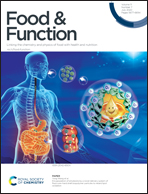Phenolic compounds from Nerium oleander leaves: microwave assisted extraction, characterization, antiproliferative and cytotoxic activities
Abstract
A microwave-assisted extraction (MAE) method was used for the extraction of phenolic compounds from Nerium oleander leaves. The influence of variables such as ethanol concentration, microwave power, irradiation time and liquid/solid ratio on polyphenol extraction was modelled using a second-order regression equation based on response surface methodology (RSM). The optimal conditions for MAE were: extraction solvent 35% ethanol concentration, 500 W microwave power, 60 s irradiation time and a solvent/material ratio of 20 mL g−1. Under optimal MAE conditions, the recovery of TPC was 25.752 mg GAE per g dw. 19 compounds have been identified by HPLC-ESI-MS/MS analysis; the main compounds identified were chlorogenic acid, rutin and quinic acid esters, such as caffeoylquinic acids and dicaffeoylquinic acids. Additionally, the optimized extract demonstrated potential to inhibit HT29 colorectal cancer cell growth (EC50 = 2.432 μg mL−1) without presenting cytotoxicity in confluent Caco-2 cells, a model of human intestinal epithelium. These results supply new information about the phenolic composition of Nerium oleander leaves and their antiproliferative effect.



 Please wait while we load your content...
Please wait while we load your content...